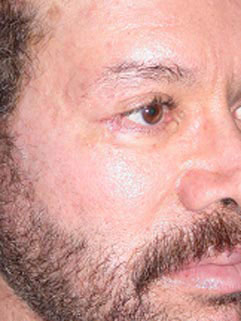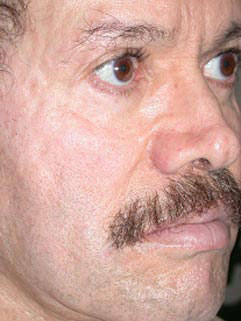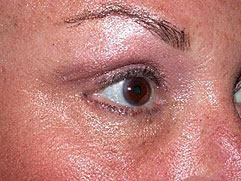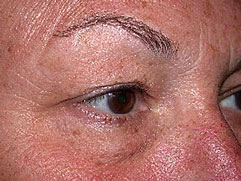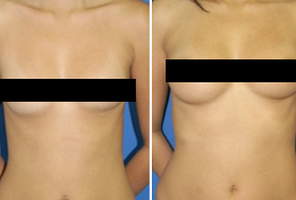Blepharoplasty is surgical procedure performed on either the upper or lower eyelid to improve the appearance of the skin around the eye. On the upper eyelid, it is used to correct redundant (droopy) skin of the upper eyelid and forehead. As we age, skin of the eyelid loses elasticity. Furthermore, the structures that support the skin of the forehead weaken, leading to excess skin that may hang over the edge of the brow. Finally, the muscles and the fat of the upper eyelid can change with age, leading to an unattractive bulge. Traditionally, blepharoplasty involves removing the excess skin of the upper lid to restore a sharp eyelid crease and give the upper eyelid a smooth look. For people with bulging fat in the upper eyelid, blepharoplasty can also include excision of the bulging fat. Lower eyelid blepharoplasty is usually performed to correct the appearance of “bags” under the eyes. So called “bags” are caused from fat that is normally behind the eye that bulges in front of the eye muscles because of aging.
Video: Dr. Jason Diamond performs Eyelid Surgery (Blepharoplasty) on Dr. David Matlock.
View the video by clicking on the play icon. |
How is Eyelid Surgery performed?
Upper eyelid blepharoplasty is performed in an outpatient clinic using local anesthetics. You may also be given a sedative to relax you during the procedure. Usually, a pre-operative consultation is performed during which time you meet the surgeon, discuss the procedure, and are examined. Depending on the nature of the cosmetic problem, different procedures may be offered. For example, if your eyelids are droopy because of laxity of the forehead structures, a brow lift (see next section) may be offered instead of blepharoplasty. On the day of the procedure, the first step is examination and marking the upper eyelid. Local anesthetic (usually lidocaine) is injected into the upper eyelid to numb it. Removal of the excess skin is then performed using either a scalpel, carbon dioxide laser, or radiofrequency cutting. For those patients with bulging fat in the upper eyelid, the fat is then gently removed. The wound is then closed with sutures. Your surgeon may prefer absorbable (dissolving) or non-absorbing sutures that will be removed later.
Blepharoplasty is performed in a similar manner as described above. However, depending on the nature of the cosmetic defect, different techniques may be used. For patients with both bulging and droopy lower eyelids, an incision is made on the outside of the eyelid, just below the eyelash line. The various eyelid tissues are separated from one another and the bulging fat is identified and gently removed. The excess skin is then cut out and the wound is sutured. For patients with bulging but not droopy eyelids, an incision is made along the inner side of the eyelid. The eye itself is anesthetized with eye drops and then the eyelid skin is injected with local anesthetic. A shield is placed over the eye to protect it. Incisions are made in the inner lower eyelid and the bulging fat is gently removed. More Eyelid Surgery Facts...
What is the recovery period like after Eyelid Surgery?
Usually, you will need a ride home after the procedure. Your eyelids will be lubricated and bandages may or may not be applied. After the anesthetic wears off, your eyelids may feel tight and sore. Your surgeon may offer you a prescription for pain medication which you should fill before the procedure. If the post-operative pain is severe, this may indicate a serious problem and you need to call your surgeon immediately. Once at home, keep your head elevated and use cold compresses. It is important to keep your eyes clean; your doctor will give you instructions on how to do this. Eye drops or ointments will be provided to lubricate the eyes. Bruising is normal and peaks about a week after the procedure. The bruises may last 2-4 weeks but can usually be covered with makeup by about 10 days. Activity can usually be resumed in 3-5 days and most patients return to work about 10 days after the procedure. Swelling usually lasts one to two weeks but in some cases can last months. More Eyelid Surgery Facts...
What are risks are associated with Eyelid Surgery?
The most important step in any cosmetic procedure is having a realistic expectation of the outcome and understanding the potential complications. You should have a lengthy discussion with your surgeon prior to the procedure so that you have a good understanding of what to expect. Some of the common complications are discussed below but this discussion should never replace the discussion with your surgeon. The most common complaints after blepharoplasty are asymmetry (one side does not match the other) and removal of too little skin. It is important to be realistic about how much skin can safely be removed. If too much skin is removed, the eyelid will not function properly(see further discussion below). Perfect symmetry is very difficult to achieve and it is possible that you may need a touch up procedure after the initial procedure to achieve symmetry. It is also important to realize that the final result cannot be judged for many weeks after the procedure because swelling of the eyelid from the procedure can make the eyelid look abnormal. Bleeding into the skin (called a hematoma) after the procedure is a common complication. It is critical to stop all over the counter and prescription medications that increase the risk of bleeding. Furthermore, after the procedure, you must avoid vigorous activity, lifting, bending, or any other activity that may increase the risk of bleeding. The worst complication of blepharoplasty is called retrobulbar hematoma and occurs after lower lid blepharoplasty. Bleeding into the space in front of the eye can occur, resulting in pressure on the optic nerve and its blood supply. When left untreated, permanent blindness can occur. Early diagnosis—recognized by eye pain or visual changes—is critical. Another complication is called lagophthalmos which is the inability to completely close the eyelid. Lagophthalmos can be transient from eyelid swelling, or permanent if too much skin from the upper lid was removed. This causes drying of the cornea and then inflammation of the cornea. Lubricating ointments are used to treat this temporarily but if it becomes permanent, a skin graft may have to be used to correct the problem. Scarring can also occur post-operatively, leading to a poor cosmetic outcome. Scarring of the lower lid can pull the lower lid out, leading to an unnatural appearance and dysfunction of the lower eyelid. You and your surgeon should discuss these and any other risks and decide if this is the right procedure for you. More Eyelid Surgery Facts...
Eyelid Surgery Related Articles
Disclaimer: This information is intended only as an introduction to this procedure. This information should not be used to determine whether you will have the procedure performed nor does it guarantee results of your elective surgery. Further details regarding surgical standards and procedures should be discussed with your physician.
By OnlineSurgery Staff
Updated: October 30, 2008
